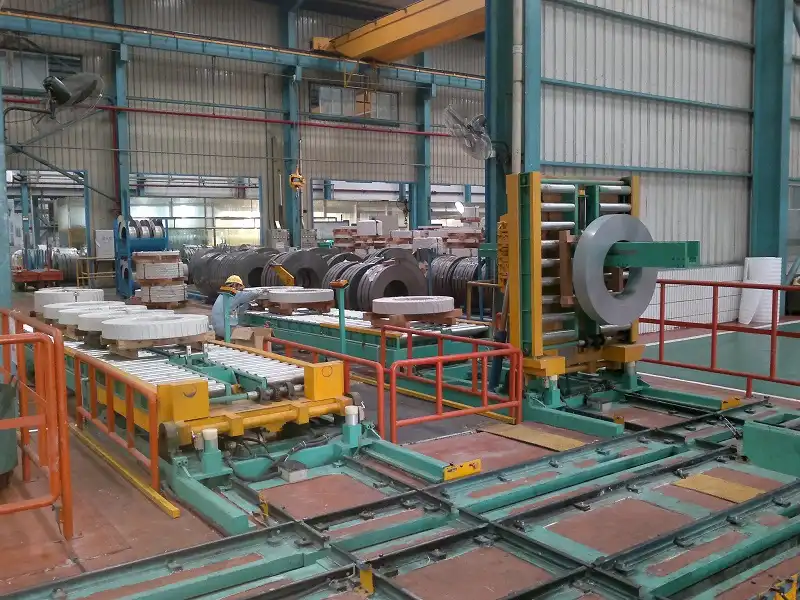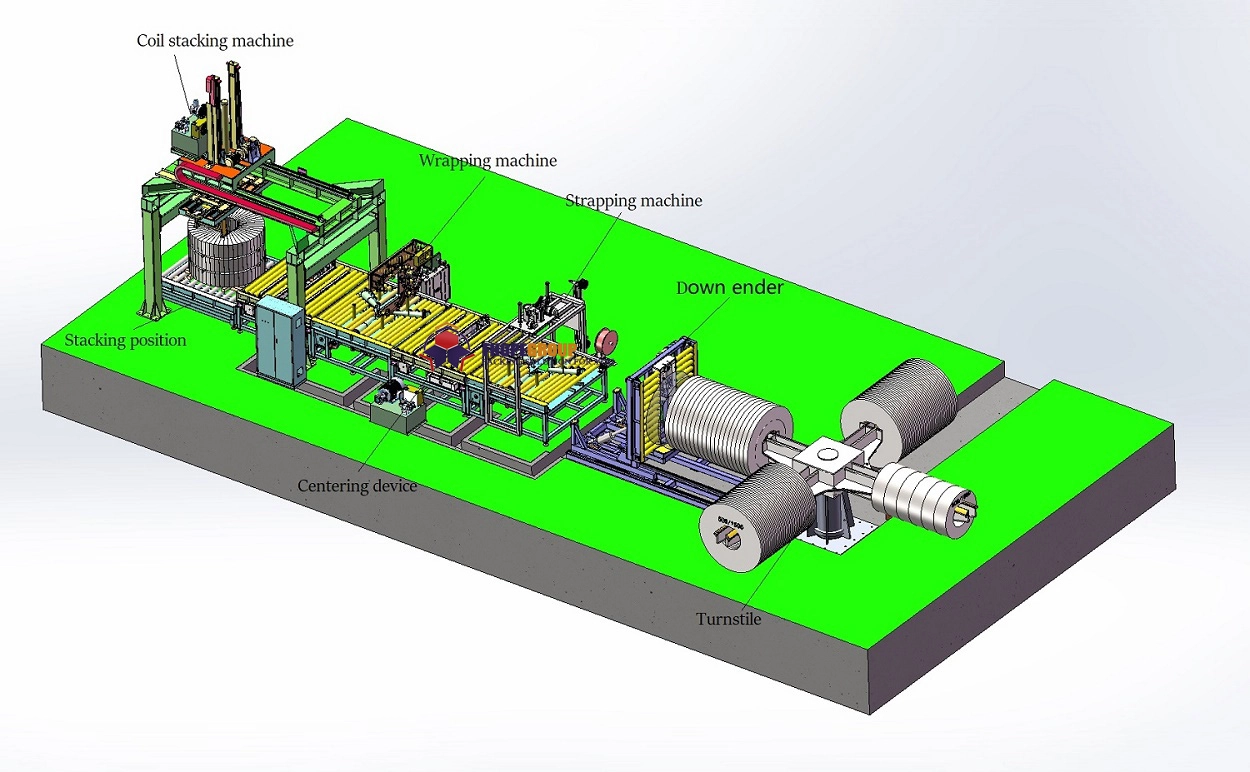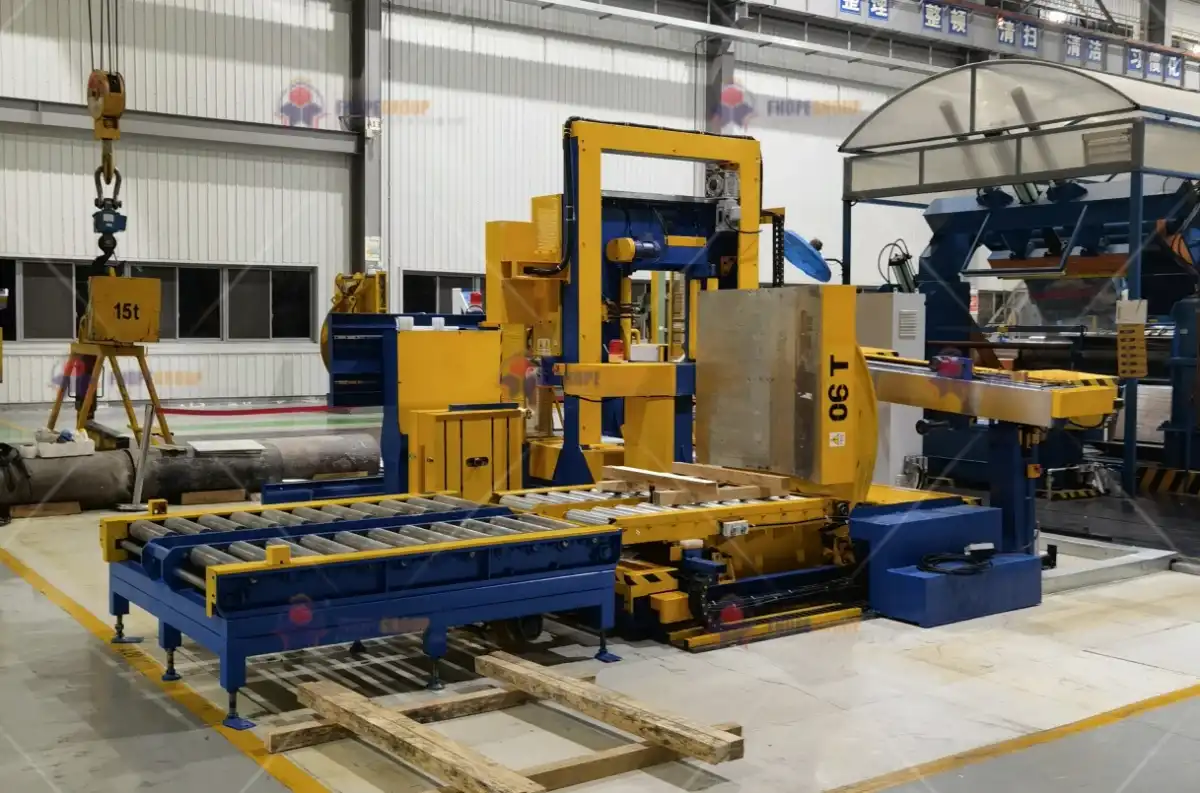Indonesian steel mills and manufacturing plants are the backbone of the country's growth. But I know you face a constant battle with rising energy costs. These fluctuating prices can eat into your profits and make it difficult to plan for the future. You might see your packing line as just the final step, but what if it's a hidden source of energy waste? An inefficient line slowly drains power, hour by hour, day after day. It's a problem that quietly erodes your margins on every product you ship. But you can change this. By focusing on specific energy-saving features, you can turn your packing line from a cost center into a smart, efficient asset that actively saves you money.
Indonesian engineers should look for packing lines with a combination of key energy-saving features. These include high-efficiency motors (IE3 or higher), Variable Frequency Drives (VFDs) to match power to the load, intelligent automation with sleep modes for idle periods, regenerative braking to capture and reuse energy, and optimized mechanical designs that reduce friction and weight.

I've spent my entire career in this industry, from working on the factory floor to building my own company, SHJLPACK. I’ve seen firsthand how small details in machine design can lead to huge differences in long-term operational costs for my clients. It's not just about the purchase price; it's about the total cost of ownership. Let's walk through these features one by one. I want to share what I've learned so you can make a smarter, more profitable investment for your plant.
How Do High-Efficiency Motors and VFDs Actually Reduce Power Consumption?
You see the technical specifications on a proposal, and they mention motor types and drives. But do you ever stop to think about how much money a standard, less efficient motor is actually costing you every day? It’s like having a slow leak in your factory's budget. It doesn't seem like much at any given moment, but over a year, it adds up to a significant and unnecessary expense. The good news is that upgrading to high-efficiency motors and adding Variable Frequency Drives (VFDs) can plug that leak for good.
High-efficiency motors, rated IE3 or IE4, are designed to convert more electrical energy into useful mechanical work, losing less energy as waste heat. Variable Frequency Drives control the motor's speed and torque, ensuring it only uses the exact amount of power needed for the task at hand, instead of running at full speed all the time.

The Clear Difference in Motor Efficiency
When you're looking at a packing line, the motors are the heart of the operation. They drive the conveyors, the wrapping ring, and the strapping heads. An inefficient motor gets hotter because it's wasting electricity as heat. A high-efficiency motor runs cooler because more of that electricity is doing what you want it to do: move your product.
The International Electrotechnical Commission (IEC) sets the standards for this, called IE codes.
- IE1 is Standard Efficiency.
- IE2 is High Efficiency.
- IE3 is Premium Efficiency.
- IE4 is Super Premium Efficiency.
Moving from an older IE1 or IE2 motor to an IE3 or IE4 motor can result in an efficiency gain of 3-8%. That sounds small, but let's look at the numbers for a single motor running in an Indonesian facility.
| Feature | 15 kW IE2 Motor | 15 kW IE3 Motor | Annual Impact |
|---|---|---|---|
| Efficiency | 90.0% | 92.6% | 2.6% Improvement |
| Power Draw at Full Load | 16.67 kW | 16.20 kW | 0.47 kW Saved |
| Annual Run Time | 6,000 hours | 6,000 hours | (2 shifts, 6 days/week) |
| Annual Energy Saved | - | 2,820 kWh | (0.47 kW * 6000h) |
| Cost Savings (IDR 1,500/kWh) | - | IDR 4,230,000 | Per motor, per year |
Now, multiply that by the 10, 15, or even 20 motors on a complete packing line. The savings become a serious factor in your operational budget.
Why VFDs Are a Game-Changer
A motor without a VFD is like a car with only one speed: maximum. It's either on full blast or it's off. But a packing line's workload isn't constant. A conveyor might need to move a heavy steel coil one minute and be empty the next. The wrapping ring only needs full power during the wrapping cycle. A VFD acts like a gas pedal for the motor. It adjusts the electrical frequency, which precisely controls the motor's speed and torque.
I remember visiting a client in Cilegon. He was a sharp engineer, but he was skeptical about the ROI of adding VFDs to all the conveyor motors on his new line. I asked him to trust me. We installed power monitors on two identical conveyors—one with a VFD, one without. The conveyor without the VFD ran at full speed constantly. The one with the VFD sped up to accept a coil, then slowed to a crawl until the next one arrived. After one week, the data was clear. The conveyor with the VFD used 60% less energy. He became a believer right then and there. This isn't just theory; it's a practical, proven way to cut costs.
Can Smart Automation and Sleep Modes Make a Real Difference in a 24/7 Operation?
Your production line is busy, but it's never truly running 100% of the time. There are small gaps between coils, short pauses for quality checks, or longer waits during shift changes. During these pauses, do your machines truly stop consuming power? The reality is that many motors, hydraulic pumps, and control panels sit in an idle state, drawing standby power for no productive reason. This "phantom load" is a constant drain on your resources, and in a 24/7 plant, it adds up to a surprisingly high cost over a year. Smart automation with intelligent sleep modes addresses this problem directly, ensuring that power is only used when and where it's absolutely needed.
Yes, intelligent sleep modes and smart automation can make a huge difference in a 24/7 operation. They automatically power down non-critical components during idle periods and can restart them instantly when a product is detected. This simple function eliminates wasted standby energy consumption, directly cutting operational costs without impacting production throughput.

How Intelligent Sleep Modes Work
This is much smarter than a simple on/off switch. A modern packing line's control system (the PLC) can be programmed to monitor the flow of products. If the sensor at the entry of the line doesn't detect a new coil for a pre-set amount of time—say, 30 or 60 seconds—it triggers the sleep mode.
Here's what happens:
- Detection: The PLC confirms the line is idle and safe.
- Partial Shutdown: It sends signals to power down components that are not immediately needed. This includes main drive motors for conveyors, the large motor for the wrapping ring, and hydraulic power units.
- Ready State: Critical systems like the PLC itself, safety sensors, and the main control panel remain powered on but in a low-power state. This is key. The machine is ready to wake up instantly.
- Instant Wake-Up: As soon as a sensor detects an incoming coil, the PLC immediately powers up all the necessary components. The entire process is so fast that the operator doesn't even notice a delay.
I was once working with a large steel service center in Surabaya. The manager, a very practical man, told me, "Vincent, my line runs almost continuously. How much can a few seconds of sleep mode really save?" I asked for their production data. We analyzed it and found that even in their high-throughput facility, the small gaps between coils, plus short scheduled pauses, added up to 18% of the total powered-on time. They were paying for electricity for almost two hours in every ten-hour shift where the machine was doing absolutely nothing. By implementing an optimized sleep mode, we cut the packing line's overall energy consumption by 12%. He was amazed. It's not about the long stops; it's about winning back the wasted energy in thousands of tiny increments every single day.
Integrating with Your Plant's Brain (MES)
This is where smart automation gets even more powerful, especially for a forward-thinking owner who is focused on digitalization. Your packing line shouldn't be an isolated island. It should be connected to your plant-wide Manufacturing Execution System (MES).
| Integration Level | How it Works | Energy-Saving Benefit |
|---|---|---|
| No Integration | Operator manually starts/stops the line. Sleep mode is based on simple timers. | Basic. Saves energy during short, unplanned gaps. |
| Basic Integration | MES sends a "stop" signal for planned downtime (e.g., lunch break). | Better. The line can enter a deeper sleep mode, shutting down more components. |
| Advanced Integration | MES communicates upcoming delays. E.g., "Upstream slitter has a 15-minute delay." | Optimal. The packing line can proactively enter a deep hibernation state, saving maximum power. |
When your packing line knows what's happening elsewhere in the plant, it can make smarter energy decisions. This level of connectivity turns your equipment from a simple machine into an intelligent node in your production ecosystem. It’s a key step in building the smart, data-driven factory of the future.
What Role Does Mechanical Design Play in a Packing Line's Overall Energy Footprint?
When we talk about energy efficiency, our minds often jump straight to the electrical components—the motors, the drives, the controls. We focus on the things that consume electricity. But we often overlook the foundation: the physical, mechanical design of the machine itself. A poorly designed mechanical system is like trying to drive a car with the emergency brake partially engaged. It forces the motors and drives to work much harder to do their job, constantly fighting against friction, inertia, and inefficient movement. This wastes a tremendous amount of energy. A well-engineered mechanical design is the true basis of an energy-efficient packing line.
The mechanical design plays a fundamental role by directly influencing how much work the motors have to do. Key aspects like minimizing friction with better components, reducing the weight of moving parts to lower inertia, and optimizing the geometry of movements all contribute to a lower energy footprint. A smart design reduces demand for energy at the source.

Fighting the Invisible Enemy: Friction and Inertia
Every moving part in a machine creates friction. It's an unavoidable law of physics. But the amount of friction is something a good designer can control. In the past, I've seen competing machines that used cheaper, lower-quality components to save on initial cost. But this is a classic false economy.
- Bearings and Guides: Using high-quality, low-friction roller bearings instead of simple bushings can make a huge difference in the power required to move a heavy conveyor roller or support a rotating ring.
- Transmission: A precision gearbox or a direct-drive system is far more efficient than a long, heavy chain drive that sags and wears over time. Each point of contact in that chain is a point of friction and energy loss.
Then there is inertia. Inertia is the resistance of an object to being moved. The heavier the object, the more energy it takes to get it moving and the more energy it takes to stop it. The main rotating ring on a coil wrapper is a perfect example. Early in my career, I saw designs using massive, solid steel rings. They were strong, but they were incredibly heavy. It took a powerful motor a lot of energy just to get the ring up to speed. Today, we use advanced engineering.
| Ring Design | Material | Relative Weight | Energy to Accelerate | Impact |
|---|---|---|---|---|
| Old Design | Solid Carbon Steel | 100% | High | Requires larger motor, more stress on components. |
| Modern Design | Cast Aluminum Alloy | 40-50% | Low | Smaller motor, less wear, faster cycle times. |
By using lighter, yet incredibly strong materials, we reduce the mass that the motor has to fight against every single cycle. This saves energy and also reduces wear and tear on the entire drive system, extending the life of the machine.
The Importance of Optimized Movement
This is something I learned from watching thousands of machines in operation. Wasted motion is wasted energy. A good designer obsesses over this. Does a clamp need to open 200mm when the product only requires 150mm of clearance? That extra 50mm of travel, twice per cycle (open and close), repeated thousands of times a day, adds up to a lot of wasted energy and time.
I was once asked to review a line for a potential client who was unhappy with his current supplier. I stood and watched their wrapping machine for just ten minutes. I noticed that after the wrapping was done, the entire wrapping head would lift up an extra 100mm, pause, and then lower before the coil moved on. I asked the operator why. He said, "It has always done that." It was a completely useless movement programmed into the machine from the start. We calculated that this single, pointless motion was costing them over 200 hours of wasted motor run-time per year. This is the difference between a designer who just makes something work, and a designer who understands the process and strives for elegance and efficiency. A simpler, more direct path is always the most energy-efficient path.
Beyond the Machine, How Can Data and Maintenance Strategies Lower Energy Use?
Let's say you've done everything right. You’ve invested in a brand new packing line with high-efficiency motors, VFDs, and a smart mechanical design. But a year or two later, you notice your factory's electricity bills are slowly creeping back up. What's happening? The machine itself hasn't changed, but its condition has. Components wear down, lubricants degrade, and settings drift. The machine's efficiency slowly degrades over time, and these small inefficiencies go unnoticed until something breaks. A truly comprehensive energy strategy goes beyond the initial purchase. It requires a proactive approach using data and predictive maintenance to keep your line running at peak efficiency for its entire life.
Data and maintenance strategies lower long-term energy use by transforming how you care for your equipment. By using IoT sensors to monitor key indicators like power consumption, vibration, and temperature, engineers can move from a reactive "fix-it-when-it-breaks" model to a predictive one. This allows you to identify and fix energy-wasting problems like bearing wear or motor misalignment before they escalate and cause failures.

The Shift from Reactive to Predictive Maintenance
For decades, the standard approach to maintenance was one of two things: run-to-failure (wait for it to break) or scheduled replacement (change parts every 6 months, whether they need it or not). Both are inefficient. Run-to-failure results in costly unplanned downtime and often causes secondary damage. Scheduled replacement wastes money on parts and labor for components that might still be perfectly healthy.
A machine that is developing a fault almost always uses more energy first.
- A bearing that is starting to fail creates more friction, forcing the motor to draw more current.
- A misaligned conveyor belt causes the drive motor to work harder against resistance.
- A small leak in a pneumatic line makes the air compressor run more often to maintain pressure.
These are all energy problems long before they become breakdown problems. Predictive maintenance uses data to catch these issues at the "energy problem" stage. This is a core part of the "Total Solution" philosophy we have at SHJLPACK. We don't just sell you a machine; we want to partner with you to ensure it runs optimally for years to come.
Using IoT Sensors to Listen to Your Machine
This is where the goal of digitalization becomes a practical, money-saving tool. By embedding simple, low-cost IoT (Internet of Things) sensors on critical components, your machine can tell you when it's not feeling well.
| Sensor Type | What It Measures | What It Can Predict |
|---|---|---|
| Current Transducer | Electrical current drawn by a motor. | Bearing failure, mechanical jamming, misalignment. |
| Vibration Sensor | Changes in vibration frequency and amplitude. | Gear wear, imbalance in rotating parts, bearing wear. |
| Temperature Sensor | Temperature of motors, gearboxes, bearings. | Poor lubrication, excessive friction, impending motor failure. |
| Air Flow/Pressure Sensor | Pressure in pneumatic lines. | Air leaks, failing seals, inefficient compressor use. |
A great example comes from a project we did for a steel wire producer. They were experiencing random trips on the motor for their main wire coiler. By the time maintenance arrived, the motor had cooled and would restart. We installed a simple IoT sensor package that monitored current and vibration. The data, plotted over a week, showed a clear pattern: the vibration and current would slowly climb over a two-hour period before the motor tripped. The issue was a gearbox that was overheating due to old lubricant. Without the data, it was a mystery. With the data, it was a simple fix: change the oil. That simple fix saved them hours of downtime and prevented a costly gearbox failure, all while ensuring the motor ran efficiently.
This is how you turn data into action and achieve goals like 95% equipment uptime and lower operating costs. You let the machine tell you what it needs, before it's too late.
Conclusion
Focusing on high-efficiency motors, smart automation, optimized mechanical design, and data-driven maintenance is key. This approach cuts energy costs and builds a more resilient, profitable operation for the future.





